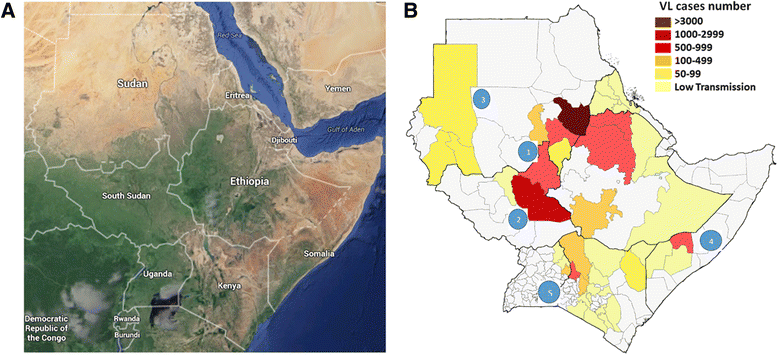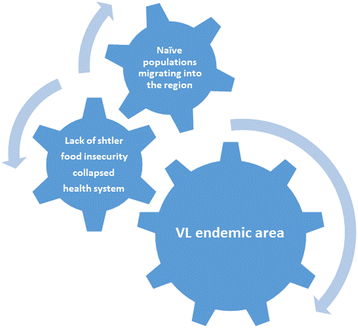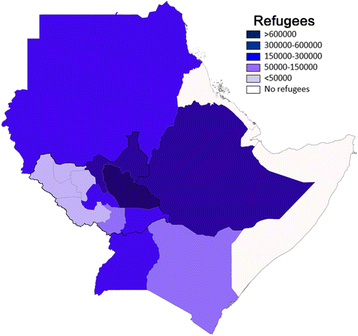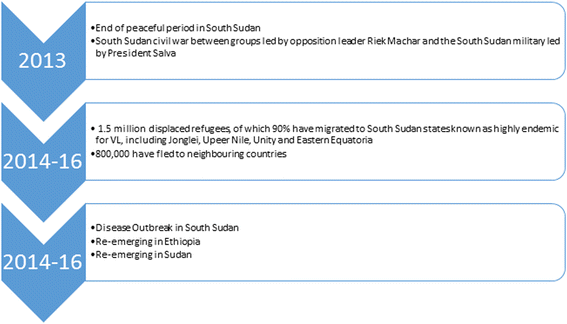A review of visceral leishmaniasis during the conflict in South Sudan and the consequences for East African countries
- PMID: 27549162
- PMCID: PMC4994383
- DOI: 10.1186/s13071-016-1743-7
A review of visceral leishmaniasis during the conflict in South Sudan and the consequences for East African countries
Abstract
Background: Visceral leishmaniasis (VL), caused predominantly by Leishmania donovani and transmitted by both Phlebotomus orientalis and Phlebotomus martini, is highly endemic in East Africa where approximately 30 thousands VL cases are reported annually. The largest numbers of cases are found in Sudan - where Phlebotomus orientalis proliferate in Acacia forests especially on Sudan's eastern border with Ethiopia, followed by South Sudan, Ethiopia, Somalia, Kenya and Uganda. Long-standing civil war and unrest is a dominant determinant of VL in East African countries. Here we attempt to identify the correlation between VL epidemics and civil unrest.
Objective and methodology: In this review, literature published between 1955 and 2016 have been gathered from MSF, UNICEF, OCHA, UNHCR, PubMed and Google Scholar to analyse the correlation between conflict and human suffering from VL, which is especially apparent in South Sudan.
Findings: Waves of forced migration as a consequence of civil wars between 1983 and 2005 have resulted in massive and lethal epidemics in southern Sudan. Following a comprehensive peace agreement, but especially with increased allocation of resources for disease treatment and prevention in 2011, cases of VL declined reaching the lowest levels after South Sudan declared independence. However, in the latest epidemic that began in 2014 after the onset of a civil war in South Sudan, more than 1.5 million displaced refugees have migrated internally to states highly endemic for VL, while 800,000 have fled to neighboring countries.
Conclusion: We find a strong relationship between civil unrest and VL epidemics which tend to occur among immunologically naïve migrants entering VL-endemic areas and when Leishmania-infected individuals migrate to new areas and establish additional foci of disease. Further complicating factors in East Africa's VL epidemics include severe lack of access to diagnosis and treatment, HIV/AIDS co-infection, food insecurity and malnutrition. Moreover, cases of post-kala-azar dermal leishmaniasis (PKDL) can serve as important reservoirs of anthroponotic Leishmania parasites.
Keywords: Civil war; Conflict zone; East Africa; Leishmania donovani; Phlebotomus orientalis; Refugees; South Sudan; Visceral leishmaniasis.
Figures





References
-
- Naghavi M, Wang H, Lozano R, Davis A, Liang X, Zhou M, et al. Global, regional, and national age-sex specific all-cause and cause-specific mortality for 240 causes of death, 1990–2013: a systematic analysis for the Global Burden of Disease Study 2013. Lancet. 2015;385(9963):117–71. doi: 10.1016/S0140-6736(14)61682-2. - DOI - PMC - PubMed
-
- Murray CJ, Barber RM, Foreman KJ, Ozgoren AA, Abd-Allah F, Abera SF, et al. Global, regional, and national disability-adjusted life years (DALYs) for 306 diseases and injuries and healthy life expectancy (HALE) for 188 countries, 1990–2013: quantifying the epidemiological transition. Lancet. 2015;386(10009):2145–91. doi: 10.1016/S0140-6736(15)61340-X. - DOI - PMC - PubMed
Publication types
MeSH terms
LinkOut - more resources
Full Text Sources
Other Literature Sources
Miscellaneous

